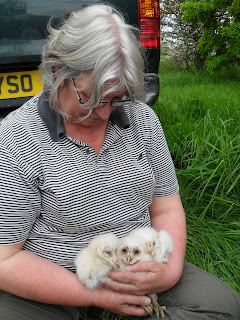It’s been a rather busy week work wise and with a few out of work
commitments we managed just one session with the nest boxes. With extra help
and the good weather that came on Wednesday, it resulted in a late finish at
work which allowed us to get another good number of boxes checked.
The Wren chicks that we came across last week in one of the artificial House
Martin nests were ready today, 5 out of 6 chicks (one dead) were ringed. Very
nice to see - and a first for all of us and the first Wren pulli ringed on the
reserve!
Checking the Wren's nest
Fal & Jean ringing the chicks
One very neat nest!
We then headed over to the Nunnery to check three of the boxes there. We found nothing in the Little Owl box and out of the two Barn Owl boxes were 3
small chicks in one and 3 of a ring-able size in the other. The chicks were big
enough to measure the longest primary out of pin - this helps age the chicks to hatching date and something we have been doing for several years.
Craig measuring the 7th primary
Three more chicks!
Next on the map was Thorganby with 2 sites to check - 3 newly hatched Barn
Owl chicks were in one box plus a hatching egg and in the other box were 3 Barn Owl
chicks of a ring-able size, plus an un-ringed adult female. She was aged due to the presence of 3 generations of primary feathers, and sexed due to her rather dark grey back and a few black spots on the breast (although not the most marked example we've ever seen), she obviously had a rather extensive brood patch as well!!
Female Barn Owl - rather dark grey back
Female Barn Owl - showing a few spots
From there we stopped off at Elvington and checked both of the water towers
that have been used by Barn Owls for many years. We re-trapped the adult female
in one, she had one newly hatched chick plus an egg. The other tower was most
interesting....in very close proximity we found 3 Jackdaw chicks and 3 Barn Owl
chicks! Obviously not too bothered about sharing the same space! All 6 chicks
were of a ring-able size.
Three Jackdaw chicks
Jackdaw chick - approximately 3 weeks old
The Motley Crew!
We finished off at Bank Island, in the box that we were expecting to find a
brood of Kestrels was nothing......but just below the box in a hole in the tree
were 2 small Tawny Owl chicks - presumably why the Kestrel box hasn’t been used
this year! Just one of the chicks was ringed, the other was too small - one to come
back to.
Tawny Owl chicks in the nest
The chick on the right was just too small for ringing
We then had a look in the Ash tree that the Jackdaws are in, we
found one chick in the nest hole that’d had 3 eggs in last week, and a quick nosey in the bottom hole that had the two original
chicks plus the 2 we put in of Jean’s, found all the chicks doing well - great
to know that it worked!
Jean's Jackdaw - 2 weeks on and ready to go
The last tree to be checked was the big Ash tree behind the office - to
reach the box it was a fairly long walk through waist high nettles plus a
rather difficult tree to climb - all for nothing - the Jackdaw’s had already
fledged! Nevermind can’t win them all!













No comments:
Post a Comment